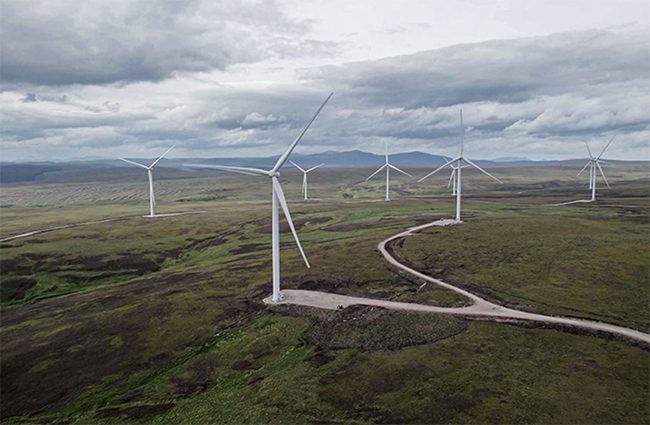The UK has a broad plan to develop a hydrogen economy as a feature of its commitment to reach net-zero carbon emissions by 2050. Energy analysts have said hydrogen not only could fuel the country’s transportation sector, it also could be used in much the same way natural gas is today—for heating, cooking, and for power generation.
The UK’s “Hydrogen Strategy” announced last year detailed what many called a “green industrial revolution,” a plan for government and industry to work together to develop at least 5 GW of low-carbon hydrogen production capacity this decade. Analysts said such production would be the equivalent of replacing natural gas to power about 3 million homes annually, in addition to helping fuel the transportation sector and supporting industry. The economic numbers were highlighted; energy experts said the UK could have a hydrogen economy worth£900 million ($1.02 billion) by 2030, with the figure rising to£13 billion ($14.7 billion) by mid-century.
The use of hydrogen to combat climate change also has been featured, with hydrogen seen as important to decarbonizing industry. Government analysis showed as much as a third of the country’s energy consumption by 2050 could be hydrogen-based. The UK’s independent Climate Change Committee agreed with officials who said hydrogen could support as much as a 78% reduction in country-wide carbon emissions by 2035.
Shubhendra Anand, head of the Chemicals, Materials, and Energy Practice at Market Research Future, a group that researches and analyzes market forces impacting the global economy, told POWER, “The UK’s first hydrogen strategy, with the vision of utilizing hydrogen in all modes of transport, including HGVs [heavy goods vehicles], rail, buses, commercial cargo, and aviation, has outlined clear plans for execution over the next eight years. The role of green/zero carbon hydrogen is pivotal to the strategy, with concrete steps taken towards production, distribution, and storage to ensure a supply network of refueling stations and provide for operational assessments of hydrogen-based vehicles for roadways, waterways, as well as aviation.”
Said Anand, “The Tees Valley Hydrogen Transport Hub is one of the examples that will provide a unified platform for government, academia, and industry.” Tees Valley in October announced it would host a£20 million ($22.6 million) competition, seeking bids from companies interested in seeing how hydrogen could provide the UK with a cleaner and more efficient transportation sector. The first phase of a pilot project already is underway at Teesside Airport in Darlington.
Ben Houchen, mayor of Tees Valley, said, “Thanks to this competition, our brilliant innovative businesses can go further to unlock the potential of hydrogen to transform our transport system and undertake vital research that—alongside plans by BP, Kellas Midstream, Northern Gas Networks and others—will cement our area as a hydrogen powerhouse.” Anand noted, “Reducing greenhouse gas emissions is one of the critical objectives of having a hydrogen strategy for the transport sector. Hence, developing green hydrogen facilities will be key to successfully implementing the strategy and moving strongly towards the UK’s targets of net-zero emissions by 2050 and cutting emissions by 78% by 2035.”
Brian Higgins, director of Advanced Technology at Babcock & Wilcox, told POWER, “Green hydrogen and other low-carbon-intensity methods of producing hydrogen are a great way to reduce the greenhouse gas footprint of heat and power. It can be blended with natural gas, to reduce the immediate carbon intensity. Eventually, it can be a direct one-for-one replacement of fossil fuels.” He continued, “The best approach doesn’t have to be an ‘all or none’ strategy as we move through the clean energy transition. The reality is, whether green hydrogen comes from thermal or renewable power, what really matters is the carbon intensity of the hydrogen. When combined with carbon capture utilization and sequestration, the production of hydrogen from fuels can be very ‘green.’ For example, producing hydrogen from waste biogenic fuels with carbon capture and sequestration is net carbon negative and is arguably greener than ‘green’ hydrogen.”
 |
|
1. The Gordonbush wind farm in Scotland could be used to produce hydrogen, according to a filing by Scottish utility SSE. Courtesy: SSE Renewables |
Producing green hydrogen from renewable energy is part of the UK’s plan. SSE, the large Scottish utility, recently submitted an application to produce green hydrogen at its 109.7-MW Gordonbush wind farm (Figure 1) in the northeast Highlands. The installation currently provides power for the local grid. According to plans filed with the Highland Council, the utility wants to install an electrolyzer system at the site “that could produce approximately 1,600 tonnes of hydrogen per annum.” The project would be among the first existing renewable energy plants used to commercially produce hydrogen.
SSE in April had announced plans to produce green hydrogen at the site, working in conjunction with Siemens Gamesa and using the latter’s Renewable Hydrogen Upgrade solution. The utility at that time had said lithium-ion batteries would be used to store energy in excess of that needed by the local grid, and had said the stored energy could be used as a power source for the electrolyzer. However, there was no mention of energy storage in the planning documents submitted to officials. SSE did not respond by press time to a request from POWER for more information about the project.
Said Anand, “Energy storage is ultra-important for hydrogen success in any economy. Electrolyzers are systems that convert water into hydrogen gas to store energy. The UK government has realized the importance and has taken steps towards ensuring infra[structure] setup for energy storage projects. A hydrogen storage project near Glasgow has been backed by nearly£10 million [$11.3 million] in UK government funding. The investment will help the Whitelee green hydrogen project develop [the] UK’s biggest electrolyzer. The project will be located beside Scottish Power’s Whitelee Windfarm, the largest in the UK [at 539 MW], with the capability to produce and store hydrogen to supply local transport providers with zero-carbon fuel.”
“Hydrogen is an excellent energy storage medium, so [energy storage] absolutely could be included in these projects,” said Higgins. “The low-cost production of hydrogen from abundant but intermittent renewable energy can be used to produce electricity when renewable energy is unavailable. Widespread application will require lower costs from more efficient electrolyzers, hydrogen storage, and fuel cells, and fortunately, these technological advances are coming. In the meantime, government incentives can help drive innovation.”
Other UK projects include using hydrogen at a natural gas–fired, grid-connected power station, in a one-year trial project announced in late October. Centrica Business Solutions said it would inject hydrogen into a gas-peaking plant in Lincolnshire. Centrica in a statement said the 49-MW plant has been “designed to meet demand during peak times or when generation from renewables is low, typically operating for less than three hours a day.” The group noted, “Mixing hydrogen in with natural gas reduces the overall carbon intensity.”
Centrica said some of the funding for the project comes from the Net Zero Technology Centre, a group established in 2017 and backed by the UK and Scottish governments. The Lincolnshire project also includes HiiROC, a group that specializes in the conversion of hydrocarbons into hydrogen and what it calls a “solid carbon byproduct,” which can be used in plastics, tires, and inks, among other products. Centrica said the trial is scheduled for the second half of 2023, and said it anticipates “no more than 3% of the gas mix could be hydrogen, increasing to 20% incrementally after the project.” Centrica added, “Longer term, the vision is to move towards 100% hydrogen and to deploy similar technology across all gas-fired peaking plant[s].”
Cam Hosie, CEO of 8 Rivers, which provides net-zero solutions, told POWER, “Hydrogen is a central pillar of the UK’s plan to decarbonize energy supply and hard-to-abate sectors. The development of scalable low-carbon hydrogen infrastructure is a core part of the UK government’s Ten Point Plan for a green industrial revolution.” Said Hosie, “Hydrogen has the potential to decarbonize heavy industry, future energy supplies, and high-horsepower transportation, a concept backed across the political spectrum. The UK approach may provide lessons for the potential rollout of green hydrogen in the U.S., namely understanding the required scale for green and blue for hydrogen production to meet demand. It also must ensure the hydrogen supply is located near an energy intensive industry—ideally at or near the point of distribution.”
Hosie said the use of hydrogen in the ongoing energy transition “needs to be at-scale, and quickly. To get there we will also need to invest in immediately scalable and readily deployable technologies, such as hydrogen with carbon capture. That in turn will create infrastructure for green hydrogen to tap into.” Hosie noted that 8 Rivers “has pioneered a new hydrogen production process called 8RH2, generating clean hydrogen while capturing all emissions. Crucially, it is cheaper than other hydrogen methods available today, and provides a scalable low-carbon hydrogen supply. This approach will allow us to decarbonize energy production across many industries as green hydrogen technology matures.”
Higgins told POWER, “Transportation applications for low-carbon intensity hydrogen offer both the highest value and highest impact use of hydrogen. This includes Power-to-X applications where hydrogen is combined with biogenic CO2 to produce other green fuels like methanol, which can be used to decarbonize shipping. The use of low-carbon-intensity hydrogen is also a simple and effective way to decarbonize industrial processes that are otherwise difficult to decarbonize. The production of electricity from hydrogen [which is often produced by electrolysis utilizing power generated from another source] is more a method of energy storage than it is a method to decarbonize power production.”
Apart from the UK, the European Union (EU) has its own hydrogen strategy, with its governing board recently approving more than $5 billion in public funding for hydrogen projects. The EU’s executive branch has said it wants 40 GW of renewable hydrogen electrolyzers to be installed across the EU by the end of the decade. European Commission President Ursula von der Leyen in her recent State of the Union address said, “Hydrogen can be a game changer for Europe. We need to move our hydrogen economy from niche to scale.” The president noted a “2030 target to produce 10 million tons of renewable hydrogen in the EU, each year.”
Anand told POWER, “The strategy laid out by the UK is impressive and has grabbed plaudits from industry and policymakers. After its exit from [the] European Union, the government needed to prioritize a localized energy transition policy. Hydrogen strategy is critical to move towards net zero emission by 2050 … it can be a model or inspiration for mature economies such as the U.S. and a few European countries.
 |
|
Table 1. Several countries worldwide have adopted strategies to produce hydrogen, often as part of a decarbonization plan for various industries. Note: MMTPA = millions of metric tonnes per annum, KTPA = thousands of metric tonnes per annum, GW/a = gigawatts per annum. Source: Market Research Future Analysis |
“Moreover, countries such as Australia, China, and Canada are planning for their hydrogen economies [Table 1] and could leave the Gulf Cooperation Council countries behind. Australia plans to increase hydrogen production sharply to supply domestic heating, transportation, electricity, and industrial sectors. The country could potentially export more than 3 Mt [million metric tons] of green hydrogen by 2040 under a high-capacity scenario and earn about $9 billion annually. Followed by this, the province of British Columbia in Canada has developed a plan to produce approximately 1.5 Mt of blue and green hydrogen by 2050 and generate export revenues of $15 billion. Additionally, China is planning to set up a green hydrogen plant that would increase the country’s local demand to 60 Mt by 2050 in the transportation, alternative feedstocks, building, heat and power, and industrial sectors.”
Said Higgins: “There are pros and cons for each strategy and certainly debates on what strategy should take the lead. In the end though, we all hope that we learn from each other and take the best examples from each strategy [and from others’ strategies], which in the end should result in overall lower costs for everyone.”
—Darrell Proctor is a senior associate editor for POWER (@POWERmagazine).











